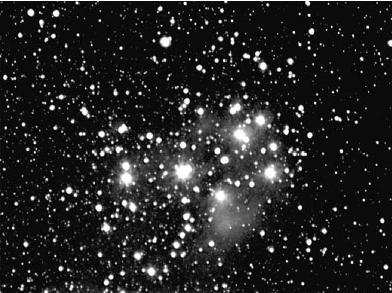LCAS Observer Challenge - December
Dave Wagner

Photo of "The Seven Sisters" or Pleiades - Courtesy of Joe Shuster
The Holidays are here! Shoveling snow, Christmas
shopping, holiday events with friends and family are all
part of the season. It can be pretty tough during this busy
season to find time for observing. You will find however
that the Nov/Dec Observer Challenge list has just the
solution to your busy schedule.
 With a pair of binoculars (and perhaps without) you
and your holiday guests can connect with the
December skies on quite a few of the challenge objects,
starting with the Pleiades, pictured above.
In this stacked, long exposure photograph, you can see
that the Pleiades are imbedded in a nebulous material. A
color image would show a blue tint, indicating a
reflection nebulae, reflecting the light of the nearby
bright stars.
With a pair of binoculars (and perhaps without) you
and your holiday guests can connect with the
December skies on quite a few of the challenge objects,
starting with the Pleiades, pictured above.
In this stacked, long exposure photograph, you can see
that the Pleiades are imbedded in a nebulous material. A
color image would show a blue tint, indicating a
reflection nebulae, reflecting the light of the nearby
bright stars.
Naked eye you should see a minimum of 6 stars, with moderate seeing you should see 9, and on a clear dark night perhaps a dozen. LCAS member Greg Lutes may have the club record for a naked eye Pleiades star count, and was mentioned in Sky and Telescope (January 1988) for his achievement. Here is an abbreviated account from Greg's observing from a dark site, southwest of Apple River Canyon near Woodbine, Ill.
"Around 1:30 AM, the Pleiades was up fairly high. I decided to take a break from my scope and sat down to plot the stars of the Pleiades on a blank piece of notebook paper. Without using my scope or binoculars, I began to observe the Pleiades. The first five stars were quickly identified - they were the four that form the square, plus the bottom left one (when facing East). The sixth one wasn't too difficult either - it was the star above the upper left one of the square. From this point, I just kept looking at the group of stars directly, then with averted vision, and back again. Over the course of about 20 to 25 minutes, stars seemed to blink in and fade out... After 20 to 25 minutes, I was pretty sure I had seen all the stars in the Pleiades that I could see that night... The next night at home I began to wonder how many stars of the Pleiades I had seen. I got out my sketch and counted; to my amazement, I had plotted out 15 stars! I dug out my Burnham's Celestial Handbook to verify the stars' positions...and they matched."
Let's next take your guests to the Andromeda Galaxy, M31 (last month's feature), spectacular in dark skies. Perhaps less spectacular but nice open clusters are M35 (in Gemini at the feet of the Castor twin) then moving up into Auriga for M37, M36 and M38. Continuing right up that line you'll arrive in Perseus, home to M34 and the double cluster, NGC869/884. The double cluster is 7000 light years distant from us, but the clusters are just few hundred light years apart.
A surprising and eye pleasing star alignment can be found in Kemble's Cascade in Camelopardalis (near Cassiopeia), a chance alignment of about 20 stars in a nearly straight line, stretching the width of five full moons. Only because our particular position in the Milky Way, do we see this random set of stars as aligned. They have no true relationship to each other in the sky. At one end of the cascade is the challenge object NGC1502, a cluster of about 45 stars.
Our final tester for your holiday party is NGC2169, nestled in the elbow area of Orion's raised arm. With 50X or more, you should be able to recognize two separate groupings, which to some look like a backward "37". Can you find it?
With just a pair of binoculars, you've just seen TEN observer challenge objects!
There are many web sites dedicated to binocular observing, such as this one. http://www.uvaa.org/BinocularResources.htm
Most all of the "Basic" Observer Challenge objects are binocular friendly, so pull those binoc's out and give some winter observing a try!





